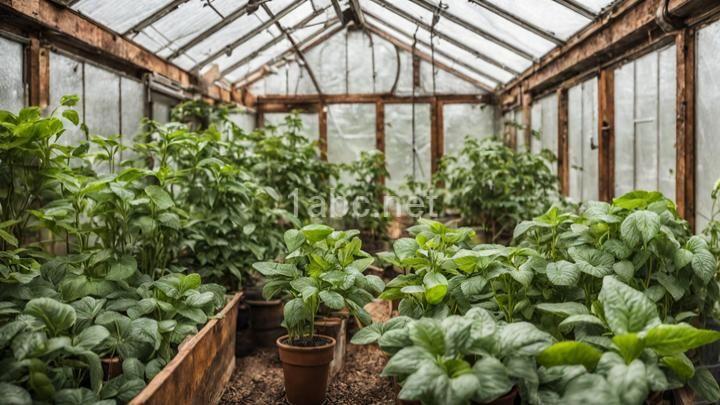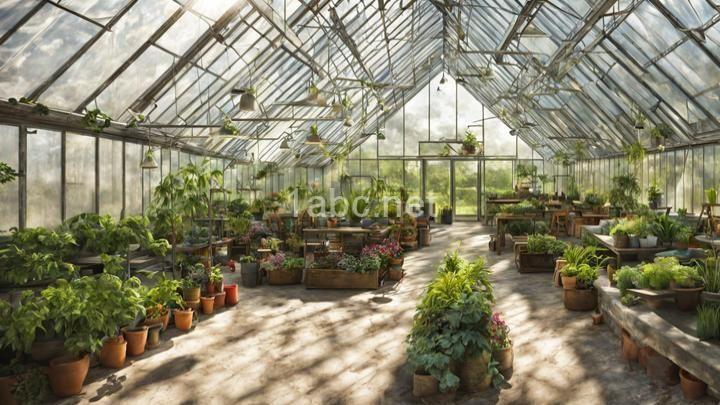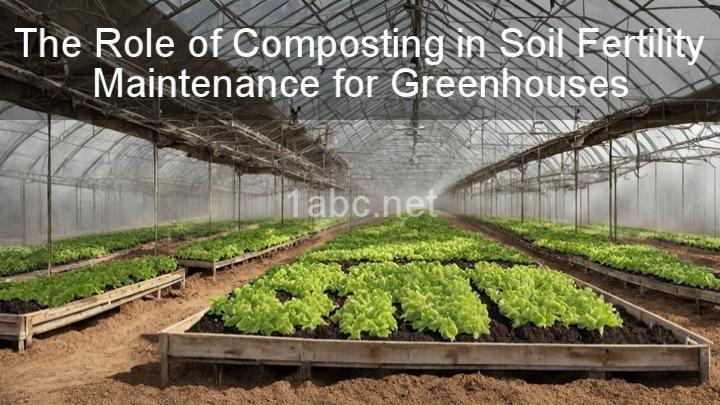How to Measure and Monitor Humidity in Your Garden Greenhouse
Introduction:
I. Understanding the Importance of Humidity in a Greenhouse
II. Recommended Tools and Equipment
III. Ideal Humidity Levels for Different Plant Types
IV. Methods to Increase Humidity
V. Methods to Decrease Humidity
VI. Monitoring and Managing Humidity Levels
VII. Common Mistakes to Avoid
Conclusion:

Introduction:
Welcome to our friendly guide on measuring and monitoring humidity in your garden greenhouse. In this blog post, we will provide you with simple and effective methods to ensure optimal humidity levels for your plants. Maintaining the right humidity is crucial for the health and growth of your plants, and with the right tools and knowledge, you can create a thriving environment. Let's dive in and learn more about humidity in your greenhouse!
I. Understanding the Importance of Humidity in a Greenhouse
Humidity plays a crucial role in promoting healthy plant growth in a greenhouse. It refers to the amount of moisture present in the air. Plants transpire water vapor through their leaves, and the humidity level affects the rate of this process. Understanding the importance of humidity will help you provide the ideal conditions for your plants.
High humidity levels are beneficial for tropical plants and those that thrive in humid environments. It helps them absorb water through their leaves and prevents them from drying out. High humidity also promotes the growth of aerial roots and helps plants retain moisture.
On the other hand, low humidity can be beneficial for succulents and cacti, which are adapted to arid environments. It reduces the risk of fungal diseases and prevents excessive moisture retention, which can lead to root rot.
However, both high and low humidity levels can have adverse effects on plants. High humidity can create a breeding ground for pests and diseases, promote mold and fungal growth, and hinder pollination. Low humidity, on the other hand, can cause wilting, leaf scorch, and hinder nutrient uptake.
II. Recommended Tools and Equipment
To effectively measure and monitor humidity in your greenhouse, you'll need a few essential tools:
- Hygrometer: A hygrometer is a device used to measure humidity accurately. It provides real-time readings and helps you understand the current humidity level in your greenhouse. There are various types of hygrometers available, including analog and digital options. Choose one that suits your needs and budget.
- Thermometer: While not solely dedicated to measuring humidity, a thermometer with a built-in hygrometer is a convenient tool for monitoring both temperature and relative humidity. It provides a comprehensive overview of the greenhouse environment and helps you make informed decisions regarding humidity adjustments.
III. Ideal Humidity Levels for Different Plant Types
Different plant species have varying humidity requirements. Here's a general guideline for common greenhouse plants:
- Tropical plants: These plants thrive in high humidity environments, typically ranging from 60-80%. The lush foliage and vibrant blooms of tropical plants are best supported by adequate moisture in the air. Maintaining high humidity can be achieved through various methods discussed later in this blog.
- Succulents/cacti: These plants are adapted to arid conditions and prefer lower humidity levels. Aim for a humidity range of 30-50% for succulents and cacti. This helps prevent excess moisture retention in their thick leaves and reduces the risk of fungal diseases.
It's important to research specific plant species to determine their unique humidity requirements. Some plants may thrive in specific humidity ranges outside the general guidelines.
IV. Methods to Increase Humidity
If you find that the humidity in your greenhouse is too low for your plants' needs, there are several practical techniques to increase humidity levels:
- Misting: Misting involves spraying a fine mist of water directly onto the plants or into the air. This temporarily increases moisture in the greenhouse, providing a quick boost in humidity. However, it is essential to avoid excessive misting, as it can lead to waterlogging or promote disease if done incorrectly.
- Water trays or humidifiers: Placing water trays or using humidifiers in your greenhouse can help maintain consistent humidity levels. Evaporation from the water surface increases the moisture content in the air. Monitor the humidity levels regularly and adjust the number of water trays or the operation of the humidifiers accordingly.
V. Methods to Decrease Humidity
If the humidity in your greenhouse is too high, there are solutions to reduce excessive moisture:
- Ventilation: Adequate airflow and ventilation are crucial for maintaining the right humidity levels. Install fans or vents to circulate the air and remove excess moisture. This helps prevent the buildup of stagnant air, which can lead to fungal diseases and pest infestations. Consider natural ventilation options such as windows and vents, as well as mechanical options like exhaust fans.
- Dehumidifiers: If natural ventilation is not sufficient, consider using dehumidifiers to remove excess moisture from the air. Dehumidifiers work by condensing the moisture in the air and collecting it in a reservoir. Choose a dehumidifier suitable for the size of your greenhouse and monitor its operation regularly.
VI. Monitoring and Managing Humidity Levels
Regular monitoring and adjustment of humidity levels are crucial for maintaining optimal conditions for your plants. Here are some tips to help you effectively manage humidity in your greenhouse:
- Record data from hygrometer readings: Keep a record of humidity levels at different times of the day and under different weather conditions. This will help you identify patterns and make informed adjustments to your greenhouse environment.
- Create a schedule for checking and adjusting humidity levels: Set a regular schedule to monitor humidity levels and make necessary adjustments. Check the readings at least once a day, preferably in the morning when humidity is typically higher. Adjust ventilation, misting, or other methods based on the recorded data and the specific requirements of your plants.
VII. Common Mistakes to Avoid
While measuring and monitoring humidity levels, it's essential to avoid common mistakes that can hinder your plants' growth. Here are a few pitfalls to watch out for:
- Over-reliance on guesswork instead of using accurate measurement tools: Guessing humidity levels based on subjective observations can lead to incorrect assumptions and ineffective adjustments. Invest in a reliable hygrometer to ensure accurate readings.
- Neglecting to consider the specific needs of different plant species: Each plant has unique requirements, and what works for one may not work for another. Research the specific humidity needs of your plants and adjust accordingly.
Conclusion:
Maintaining optimal humidity levels is crucial for the health and growth of your plants in a garden greenhouse. Understanding the importance of humidity, using the right tools, and following the recommended methods for increasing or decreasing humidity will help you create an ideal environment for your plants to thrive. Regular monitoring and adjustment based on accurate data will ensure your plants receive the moisture they need. With the knowledge gained from this guide, you can confidently measure and monitor humidity in your garden greenhouse. Happy gardening!
FREQUENTLY ASKED QUESTIONS
What is the importance of measuring and monitoring humidity in a garden greenhouse?
Measuring and monitoring humidity in a garden greenhouse is important for several reasons:
- Plant health: Different plants have different optimal humidity levels. Monitoring humidity allows you to maintain the ideal conditions for your specific plants, promoting healthy growth and preventing diseases.
- Transpiration control: Humidity affects the rate at which plants release moisture through their leaves, known as transpiration. Controlling humidity levels helps manage water loss, preventing plants from drying out or becoming overhydrated.
- Disease prevention: High humidity levels can create a favorable environment for fungal growth and the spread of plant diseases. Monitoring humidity allows you to take timely action, such as adjusting ventilation or using dehumidifiers, to prevent disease outbreaks.
- Pest management: Some pests thrive in high humidity conditions. By monitoring and maintaining optimal humidity levels, you can help reduce the risk of pest infestations in your greenhouse.
- Energy efficiency: By tracking and adjusting humidity levels, you can optimize the greenhouse environment and reduce energy consumption. For example, during cooler months, maintaining higher humidity can help retain heat, while in warmer months, lowering humidity can aid in cooling.
Overall, measuring and monitoring humidity in a greenhouse provides valuable insights to create an optimal growing environment, ensuring the health and success of your plants.
How does humidity affect plant growth and health in a greenhouse?
Humidity plays a crucial role in plant growth and health in a greenhouse. Here's how it affects them:
- Transpiration: Humidity affects the rate of transpiration, which is the process of water movement through plants. Higher humidity levels reduce evaporation from leaves, resulting in slower transpiration. This can be beneficial for plants by conserving water during dry periods.
- Disease prevention: High humidity can create a favorable environment for fungal diseases, such as powdery mildew, gray mold, and downy mildew. These diseases thrive in moist conditions, so controlling humidity in a greenhouse is essential to minimize the risk of plant infections.
- Nutrient uptake: Proper humidity levels are necessary for efficient nutrient uptake by plants. When humidity is too low, plants can experience water stress, affecting their ability to absorb essential nutrients from the soil. Maintaining adequate humidity helps optimize nutrient absorption and promote healthy plant growth.
- Stomatal regulation: Humidity also influences the opening and closing of stomata, small openings on plant leaves that regulate gas exchange. When the air is too dry, plants tend to close their stomata to minimize water loss, resulting in reduced photosynthesis. On the other hand, high humidity can cause stomata to remain open, potentially leading to excess water loss.
- Transpiration cooling: Moderate humidity levels in a greenhouse can help regulate plant temperature. Through transpiration, plants release moisture into the air, which cools the surrounding environment. This is especially beneficial during hot and dry periods, as it helps prevent overheating and dehydration in plants.
To ensure optimal plant growth and health in a greenhouse, it is essential to monitor and control humidity levels through proper ventilation, misting, or the use of dehumidifiers or humidifiers, depending on the specific needs of the plants being grown.
What are the ideal humidity levels for different types of plants in a greenhouse?
The ideal humidity levels for plants in a greenhouse can vary depending on the specific plant species and its stage of growth. However, here are some general guidelines for humidity levels:
- Tropical Plants: Many tropical plants thrive in high humidity levels, ranging from 60% to 80%.
- Houseplants: Most houseplants prefer a humidity level of around 40% to 60%.
- Succulents and Cacti: These plants prefer lower humidity levels, typically around 30% to 40%.
- Orchids: Orchids prefer higher humidity levels, ranging from 50% to 70%.
- Herbs and Vegetables: For herbs and vegetables, humidity levels between 40% and 60% are usually suitable.
Remember that these are general guidelines, and it's essential to research the specific requirements for each plant to ensure optimal growth conditions.
What tools or instruments can I use to measure humidity in my garden greenhouse?
There are several tools and instruments that you can use to measure humidity in your garden greenhouse. Here are some commonly used options:
- Hygrometer: A hygrometer is a device specifically designed to measure humidity. Analog hygrometers use a mechanical mechanism, while digital hygrometers use electronic sensors to provide accurate readings.
- Psychrometer: A psychrometer, also known as a wet-dry bulb thermometer, consists of two thermometers - one with a wet bulb and another with a dry bulb. By comparing the temperature difference between the two bulbs, you can determine the relative humidity.
- Data Logger: A data logger is a device that can monitor and record environmental parameters, including humidity, over a period of time. It provides data that can be analyzed to understand humidity patterns in your greenhouse.
- Infrared Thermometer with Hygrometer: This instrument combines the functionality of both an infrared thermometer and a hygrometer. It can measure temperature and humidity simultaneously by using infrared technology.
- Weather Stations: Weather stations are comprehensive systems that can measure various weather parameters, including humidity. They usually consist of multiple sensors to monitor different aspects of the greenhouse environment.
- Smartphone Apps: There are smartphone apps available that can use the built-in sensors in your phone to measure humidity. While not as accurate as dedicated instruments, they can provide a rough estimate.
When selecting a tool, consider factors such as accuracy, ease of use, and your specific requirements.

